This special issue contains research which navigates the territory between the real and virtual world through metaphor, cognitive model, data stream and a designer’s synergy. (…) In this volume of IJDC we attempted to solicit and select papers that explore that overlapping boundary between the physical and the virtual. In particular, we looked for research that contemplated the role of the subject user versus the machine automaton. The first paper from Maher, Gero, Smith, and Gu’s utilizes agents that sense their environment and react accordingly. What is of particular interest is in how those artificial agents responded to users who inhabit their world. The Heylighen and Segers’ DYNAMO articleBermudez cyberPRINT, a dancer interacts with the virtual manifestation of his physiological data. The performance aims to closely couple the human physical condition and the virtual condition such that, eventually, the boundaries between them are blurred. The article from Fischer and Fischer appropriates a morphogenetic biologic model to digital form finding. The human, in this case acts as a director shaping and nudging largely independent virtual actors. It is in the lack of complete control that we find such systems intriguing...
Sep 30, 2005
Immersion and Virtual Reality @ Interfaces Montréal
TUESDAY, 4th October 2005 Interface [s] Montréal 5:30pm
From aerospace to surgery, and in all things game related, the simulators and immersion environments developed to serve humankind are indispensable tools that significantly improve human knowledge and enhance our reality experience.

Speakers: Yves Gonthier - Canadian Space Agency; Jean-Claude Artonne - Immervision; Jocelyn Faubert - Université de Montréal, École d'optométrie; Carl-Éric Aubin - École Polytechnique de Montréal, Dép. génie mécanique & CHU Sainte-Justine; Luc Courchesne - Université de Montréal et Ideaction.
[Yves Gonthier]: A Real-Time Simulator for 3D Mental Image Reconstruction On-Board the International Space Station
[Jean-Claude Artonne] Immervision: Panoramic technologies in everyday applications[Jocelyn Faubert] : Understanding human behavior with immersive virtual environments
[Carl-Éric Aubin] Surgical Simulator for the Virtual Prototyping of the Surgical Instrumentation of the Scoliotic Spine
[Luc Courchesne] Panoscope 360°
![]() Tags: virtual reality
Tags: virtual reality
11:50 Posted in Positive Technology events | Permalink | Comments (0) | Tags: Positive Technology
Sep 29, 2005
Virtual reality helps stroke patients learn to drive again
Sept. 27 issue of Neurology reports results of a study, which has investigated the effect of simulator-based training on driving after stroke. The research has involved 83 subacute stroke patients randomly assigned to either simulator-based training or control group. Then, all patients were evaluated in off-road and on-road performance tests to assess their driving ability after training.  Results showed that virtual reality training improved driving ability, especially for well educated and less disabled stroke patients. However, authors warn that findings of the study may have been modified as a result of the large number of dropouts and the possibility of some neurologic recovery unrelated to training.
Results showed that virtual reality training improved driving ability, especially for well educated and less disabled stroke patients. However, authors warn that findings of the study may have been modified as a result of the large number of dropouts and the possibility of some neurologic recovery unrelated to training.
More to explore
A. E. Akinwuntan, W. De Weerdt, H. Feys, J. Pauwels, G. Baten, P. Arno, and C. Kiekens Effect of simulator training on driving after stroke: A randomized controlled trial, Neurology 2005 65: 843-850
Sung H. You, et al., Virtual Reality–Induced Cortical Reorganization and Associated Locomotor Recovery in Chronic Stroke: An Experimenter-Blind Randomized Study, Stroke, Jun 2005; 36: 1166 - 1171.Sveistrup, H. Motor rehabilitation using virtual reality, Journal of NeuroEngineering and Rehabilitation 2004, 1:10 (download full text)
16:25 Posted in Cybertherapy | Permalink | Comments (0) | Tags: Positive Technology, virtual reality
Sep 28, 2005
The singularity is near
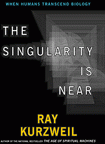 Here is a quote from a New Scientist article that sums up Kurzweil's projections:
Here is a quote from a New Scientist article that sums up Kurzweil's projections:
"Ultimately, we will merge with our technology. This will begin with nanobots in our bodies and brains. The nanobots will keep us healthy, provide full-immersion virtual reality from within the nervous system, provide direct brain-to-brain communication over the internet and greatly expand human intelligence. But keep in mind that non-biological intelligence is doubling in capability each year, whereas our biological intelligence is essentially fixed. As we get to the 2030s, the non-biological portion of our intelligence will predominate. By the mid 2040s, the non-biological portion of our intelligence will be billions of times more capable than the biological portion. Non-biological intelligence will have access to its own design and will be able to improve itself in an increasingly rapid redesign cycle."
Via smart mobs10:50 Posted in Brain training & cognitive enhancement | Permalink | Comments (0) | Tags: Positive Technology, Cognitive prosthetics
Sep 24, 2005
Open-Source Context-Aware Experience Sampling Tool
Ambient Intelligence (AmI) systems can be viewed as environments in which people will increasingly live their lives. Ubiquitous AmI technologies and systems like personal digital assistants, wearable sensors, mobile phones challenge traditional usability evaluation methods, because use context can be difficult to recreate in a laboratory setting. This view suggests that the evaluation of user’s experience with AmI systems should take place in realistic contexts, such the workplace, the home, etc. Another issue has to do with the content of the evaluation. Performance-based approaches are not suitable for AmI systems, because it is difficult to specify tasks that capture the complexity of real world activities. Moreover, experience is idiosyncratic, in that it is related to the specific bio-cultural configuration of each individual, and it can undergo changes throughout individual life and daily situations.
 The Experience Sampling Method (ESM) offers a new perspective in the analysis of these issues. ESM is based on the online repeated assessment of individual behavior and experience in the daily context. Participants describe themselves and their environment while interacting with it. They carry with them for one week an electronic beeper and a booklet of self-report forms. Whenever they receive an acoustic signal, they are expected to fill out a form. The form contains open-ended questions about situational variables such as place, activities carried out, social context, and subjective variables such as the content of thought, perceived goals, and physical conditions. The form also contains 0-12 Likert-type scales investigating the quality of experience in its various components: affect, motivation, activation, and cognitive efficiency.
The Experience Sampling Method (ESM) offers a new perspective in the analysis of these issues. ESM is based on the online repeated assessment of individual behavior and experience in the daily context. Participants describe themselves and their environment while interacting with it. They carry with them for one week an electronic beeper and a booklet of self-report forms. Whenever they receive an acoustic signal, they are expected to fill out a form. The form contains open-ended questions about situational variables such as place, activities carried out, social context, and subjective variables such as the content of thought, perceived goals, and physical conditions. The form also contains 0-12 Likert-type scales investigating the quality of experience in its various components: affect, motivation, activation, and cognitive efficiency.
Intille and colleagues at MIT have recently developed a Personal Digital Assistant-based version of the ESM which can be used for user-interface development and assessment of ubiquitous computing applications. This approach, called Context-Aware Experience Sampling, includes the possibility to assess user’s experience not only through the standard time-based protocol, but also according to the participant’s location, by means of information provided by a GPS plug-in. Thus, researchers can design experiments collecting self-reports only when the participant is near a location of interest. Moreover, users can answers via audio recording or by taking a picture with a camera.
More to explore
S. S. Intille, J. Rondoni, C. Kukla, I. Ancona, L. Bao, A context-aware experience sampling tool, CHI Extended Abstracts 2003, 972-973.
Gaggioli, A., Optimal Experience in Ambient Intelligence (2005), in Ambient Intelligence, Riva, G., Vatalaro, F., Davide, F., Alcañiz, M. (Eds.), Amsterdam: IOS Press. PDF
10:00 Posted in Research tools | Permalink | Comments (0) | Tags: Positive Technology, research tools
Sep 23, 2005
Scientific American Mind
The new edition of Scientific American Mind
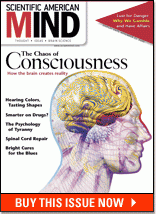
Smarter on Drugs
By Michael S. Gazzaniga
We recoil at the idea of people taking drugs to enhance their intelligence. But why?
The Movie in Your Head
By Christof Koch
Is consciousness a seamless experience or a string of fleeting images, like frames of a movie? The emerging answer will determine whether the "real world" is merely an illusion
Big Answers from Little People
By David Dobbs
In infants, Elizabeth Spelke finds fundamental insights into how men and women think
Custody Disputed
By Robert E. Emery, Randy K. Otto and William O'Donohue
The guidelines judges and psychologists use to decide child custody cases have little basis in science. The system must be rebuilt on better data
Judging Amy and Andy
By Katja Gaschler
Contrary to warnings, we can size up people pretty well based on first impressions
Hearing Colors, Tasting Shapes
By Vilayanur S. Ramachandran and Edward M. Hubbard
People with synesthesia--whose senses blend together--are providing valuable clues to understanding the organization and functions of the human brain
The Psychology of Tyranny
By S. Alexander Haslam and Stephen D. Reicher
Power corrupts, and absolute power corrupts absolutely--or does it?
Mending the Spinal Cord
By Ulrich Kraft
Researchers are finding ways to help nerves regenerate, and hope for therapies is growin
Just a Bit Different
By Ingelore Moeller
With special training early in life, children born with Down syndrome have a higher chance of becoming independent
22:39 Posted in Positive Technology events | Permalink | Comments (0) | Tags: Positive Technology
Media Fabrics
Interactive Cinema - Media Fabrics is a research initiative at MIT that focuses on a new paradigm: the "media fabric" - a semi-intelligent organism where lines of communication,  threads of meaning, chains of causality, and streams of consciousness converge and intertwine to form a rich tapestry of creative story potentials, meaningful real-time dialogues, social interactions, and personal or communal art- and story-making.
threads of meaning, chains of causality, and streams of consciousness converge and intertwine to form a rich tapestry of creative story potentials, meaningful real-time dialogues, social interactions, and personal or communal art- and story-making.
More to explore
The Media Fabrics website
13:35 Posted in Cyberart | Permalink | Comments (0) | Tags: Positive Technology, cyberart
The Virtusphere
Via Engadget
VirtuSphere is a 360-degree VR environment that allows for moving in any direction. The device consists of a large hollow sphere, placed on a special platform that allows the sphere to rotate in any direction as the user moves within it. Sensors under the sphere provide subject speed and direction to the computer running the simulation and users can interact with virtual objects using a special manipulator.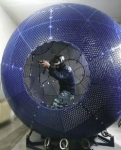
According to Virtusphere staff, the device has several potential applications in the field of training/simulations, health/rehabilitation, gaming and more. The device cost should range between $50K and $100K.
More to explore
13:30 Posted in Cybertherapy | Permalink | Comments (0) | Tags: Positive Technology, virtual reality
Sep 22, 2005
Neuroprotection in Neurological Diseases Conference
Neuroprotection in Neurological Diseases - A Promising Therapeutic Strategy or Chimera?
24-26 November 2005
Giardini Naxos (Taormina), Sicily
 Achieving proven Neuroprotection remains an unattained goal; however strategies exist which may delay disease progression in chronic conditions and which show promise of damage limitation in the acute setting. The conference will discuss best treatment practice, present new research and debate issues surrounding Neuronal Plasticity and Neuroprotection.
Achieving proven Neuroprotection remains an unattained goal; however strategies exist which may delay disease progression in chronic conditions and which show promise of damage limitation in the acute setting. The conference will discuss best treatment practice, present new research and debate issues surrounding Neuronal Plasticity and Neuroprotection.
The draft programme is available at www.sinspn.org
13:15 Posted in Positive Technology events | Permalink | Comments (0) | Tags: Positive Technology
Sep 21, 2005
Brainmirror
Via dataisnature
BrainMirror is an interactive experience where the image of the visitors brain appears mixed with his/her mirror image, using natural head movement as an interface to explore volumetric visuals of the human brain.  How it works? a motion tracker computer watches the audience through four fire-wire cameras equipped with infra-red filters. The helmets are mounted with super-bright infra-red LED's, each modulating it's brightness with it's own unique finger-print id-code.
How it works? a motion tracker computer watches the audience through four fire-wire cameras equipped with infra-red filters. The helmets are mounted with super-bright infra-red LED's, each modulating it's brightness with it's own unique finger-print id-code.
Download video (32Mb Quicktime)
15:41 Posted in Cyberart | Permalink | Comments (0) | Tags: Positive Technology
Sep 19, 2005
Between the physical and the virtual
via Pasta & Vinegar
The International Journal of Design Computing has a special Issue on the Space Between the Physical and the Virtual:
18:05 Posted in Positive Technology events | Permalink | Comments (0) | Tags: Positive Technology
The added value of eHealth
The International EHTEL conference titled Improving Care for Chronic Conditions - the added value of eHealth will take place in Rome, 10-11 October 2005, jointly organised by EHTEL, the National Research Council of Italy, Institute for Biomedical Technology in co-operation with ESQH and NIZW.
Keynotes of internationally recognised experts and contributions selected by an international Program Committee will be complemented by stakeholder views and open round table panels.
15:16 Posted in Positive Technology events | Permalink | Comments (0) | Tags: Positive Technology
Collective intelligence - The Transitioner
Down through the media, overhead machineries will make us hear the voice of the multiple. Still indiscernible, soften by the hazes of the future, flooding another humanity with its murmur, we have an appointment with the surlanguage
Pierre Lévy – "Collective Intelligence"
 The Transitioner.org is wiki which brings together those who want to marry the economy and Collective Intelligence in order to build a fair world.
The Transitioner.org is wiki which brings together those who want to marry the economy and Collective Intelligence in order to build a fair world.
Discover here if you are a transitioner (I discovered I am)
More to explore
Blog of Collective Intelligence
Improving the efficiency of social ecosystems
13:05 Posted in Social Media | Permalink | Comments (0) | Tags: Positive Technology, complex networks
Video games promoted as effective health-care training
Games for Health is a project produced by Serious Games Initiative to promote best practices, community building, and research into how cutting-edge game design and development methodologies can aid in the creation of health tools that range from direct patient application, to personal health education, and workforce initiatives.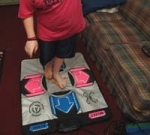
Examples of these applications include the following:
- Dance Dance Revolution: The popular dance game from Konami features an exercise mode. You set goals and play while it reports calorie burn from game sessions.
- In The Netherlands, VSTEP (Virtual Safety Training and Education Platform) has enjoyed success developing 3-D simulations for low-cost PC hardware. The "virtual experiences" are used for training oil-rig workers, emergency services, port authorities, hospital staff and military.
- Cardiac Arrest: A computer adventure game that simulates the diagnosis and treatment procedures for people suffering from various forms of cardiac arrest.
- VR Phobia: The Virtual Reality Medical Center has modified commercial games to create effective treatments for patients suffering from common phobias, including fear of flying, spiders, heights, and driving.
More to explore:
The “Serious Games Summit” is being held October 31st - November 1st, 2005, in Washington D.C. Areas of discussion range from the military and government, to health and education.
http://www.seriousgamessummit.com/home.html
“Games For Health 2005″, September 22-23, 2005, Baltimore, Maryland.
http://www.gamesforhealth.org/events.html
11:55 Posted in Serious games | Permalink | Comments (0) | Tags: serious gaming
Sep 17, 2005
View of cell-phone activity in Graz
via Future Feeder
Digital Derive is a platform developed senseable city lab that allows to visualize the volume & geographic source of cell phone usage in Graz, showing a visual conceptual layer in the use & experience of the city.
 From the lab web site:
From the lab web site:
Digital Derive harnesses the potential of mobile phones as an affordable, ready-made and ubiquitous medium that allows the city to be sensed and displayed in real-time as a complex, pulsating entity. Because it is possible to simultaneously 'ping' the cell phones of thousands of users - thereby establishing their precise location in space at a given moment in time - these devices can be used as a highly dynamic tracking tool that describes how the city is used and transformed by its citizens. The polis is thus interpreted as a shifting entity formed by webs of human interactions in space-time, rather than simply as a fixed, physical environment. Digital Derive provides a platform upon which the contemporary city can register the flux and traces its self-constructing and open-ended nature. Previous initiatives, notably Laura Kurgan's 'You Are Here: Museu' (1996) and the Waag Society's 'Amsterdam Real-Time' (2002) initiated this process by exploring the qualities and potential of GPS technology. Digital Derive builds on an expands these efforts by using cell phone technology, for the first time, to radically increase the interactive capacity and number of users involved in the mapping of the city. Digital Derive (re)presents the city displayed simultaneously in the Kunsthaus Graz and in a publicly accessible website.
19:55 Posted in Information visualization | Permalink | Comments (0) | Tags: Positive Technology, complex networks
Sep 16, 2005
Non-invasive neural interface technology
Via Engadget (thanks to Giuseppe Riva)
NeuroSky Inc. claims to have developed a non-invasive neural sensor and signal processing technology that converts brainwaves and eye movements into electronic signals to control a range of electronic devices.
According to Neurosky, neural interface technology promises to simplify cell phone-based applications that today require error-prone human input, as well as revolutionize applications from gaming to medical diagnostics and therapy.
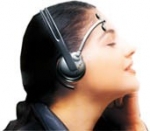 EETimes reports that five companies, including a Bluetooth headset provider, game console maker and trucking company, have signed up to market end-user products containing NeuroSky's chips.
EETimes reports that five companies, including a Bluetooth headset provider, game console maker and trucking company, have signed up to market end-user products containing NeuroSky's chips.
From the company website:
NeuroSky, a fabless semiconductor/module company, has developed a non-invasive neural sensor and signal processing technology that converts brainwaves and eye movements into useful electronic signals to communicate with a wide range of electronic devices, consoles, and computers. While brainwaves have been used as a form of diagnostics and therapy in neurosciences for years, the related technology has never reached a large audience due to price/size constraints, inconvenient physical limitations, and/or invasive surgical procedures. NeuroSky draws from this research and adapts it to commercialize neural interface technologies for various attractive global markets.
More to explore
13:00 Posted in Brain-computer interface | Permalink | Comments (0) | Tags: Positive Technology, brain-computer interface
Sep 15, 2005
ICare Haptic Interface for the blind
Via the Presence-L Listserv
(from the iCare project web site)
iCare Haptic Interface will allow individuals who are blind to explore objects using their hands. Their hand movements will be captured through the Datagloves and spatial features of the object will be captured through the video cameras. The system will find correlations between spatial features, hand movements and haptic sensations for a given object. In the test phase, when the object is detected by the camera, the system will inform the user of the presence of the object by generating characteristic haptic feedback. I Care Haptic Interface will be an interactive display where users can seek information from the system, manipulate virtual objects to actively explore them and recognize the objects.
The system will find correlations between spatial features, hand movements and haptic sensations for a given object. In the test phase, when the object is detected by the camera, the system will inform the user of the presence of the object by generating characteristic haptic feedback. I Care Haptic Interface will be an interactive display where users can seek information from the system, manipulate virtual objects to actively explore them and recognize the objects.
More to explore
15:35 Posted in Future interfaces | Permalink | Comments (0) | Tags: Positive Technology, Future interfaces
Mind & Life XIII
The Mind & Life Institute presents: MIND & LIFE XIII Co-hosted by Georgetown University Medical Center and The Johns Hopkins University School of Medicine. The Dalai Lama will participate fully in all sessions.
The Science and Clinical Applications of Meditation DAR Constitution Hall, Washington DC November 8 - 10, 2005 Jointly sponsored by The Mind & Life Institute and CME-accredited by Georgetown University Hospital. The conference builds on the growing interest in meditation within modern medicine and biomedical science that has arisen over the past thirty years and further explores the emerging clinical opportunities.
Conference Sessions
1. Meditation-Based Clinical Interventions: Science, Practice, and Implementation
2. Possible Biological Substrates of Meditation
3. Clinical Research I: Meditation and Mental Health
4. Clinical Research II: Meditation and Physical Health
5. Integration & Final Reflections
Speakers
Ajahn Amaro, B.Sc. — Abhayagiri Monastery
Richard J. Davidson, Ph.D. — University of Wisconsin-Madison
Jon Kabat-Zinn, Ph.D. — U. of Mass. Medical School, Emeritus
Daniel Kahneman, Ph.D. — Princeton University
Helen S. Mayberg, M.D. — Emory University
Robert M. Sapolsky, Ph.D. — Stanford University
Zindel V. Segal, Ph.D. — University of Toronto
David S. Sheps, M.D. — University of Florida
John F. Sheridan, Ph.D. — Ohio State University
Wolf Singer, M.D., Ph.D. — Max-Planck-Institut für Hirnforschung
Ralph Snyderman, M.D. — Duke University Medical Center
Panelists
Jan Chozen Bays, M.D. — Great Vow Zen Monastery
Joan Halifax, Ph.D. — Upaya Zen Center
Father Thomas Keating, OCSO — St. Benedict's Monastery
Margaret E. Kemeny, Ph.D. — University of California-SF
Jack Kornfield, Ph.D. — Spirit Rock Meditation Center
Matthieu Ricard, Ph.D. — Shechen Monastery
Sharon Salzberg, R.N. — Insight Meditation Society
Bennett M. Shapiro, M.D. — Merck Research Laboratories, Emeritus
Esther M. Sternberg, M.D. — National Institute of Mental Health
John D. Teasdale, Ph.D. — MRC Cog. & Brain Sci. Unit, Emeritus
B. Alan Wallace, Ph.D. — Santa Barbara Institute
Mind and Life Dialogues
Mind and Life Institute XIII is the latest in a series of dialogues between scientists, the Dalai Lama, and other Buddhist contemplatives on areas of mutual interest at the intersection of western empirical science and the contemplative traditions and their associated methodologies, psychologies, and philosophies. Prior to 2003, all of these meetings have been held in private; however books describing them have been published and are widely available. Investigating the Mind 2005: The Science and Clinical Applications of Meditation is the second Mind and Life Dialogue that will be open to a large audience, consisting primarily of people working in the fields of medicine, clinical psychology, psychiatry, and neuroscience, as well as students in these fields.
14:57 Posted in Positive Technology events | Permalink | Comments (0) | Tags: Positive Technology
Sep 14, 2005
The Stress Eraser
Via Medgadget
The Stress Eraser from Helicor claims to reduce cronic stress. Designed by Frog design, Stress Eraser is a standalone device that induces relaxation through breathing exercises programmed in. 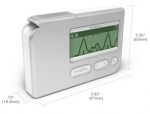
I prefer a glass of wine, but the design is nice-looking
13:25 Posted in Emotional computing | Permalink | Comments (0) | Tags: Positive Technology, Emotional technology
Sep 12, 2005
Social Networks as Health Feedback Displays
In this paper published on September/October issue of IEEE Pervasive Computing Journal Margaret E. Morris describes how social-networking and pervasive computing technologies can be used to help reduce feelings of social isolation and depression in elderly individuals. 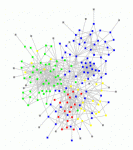 In this approach, sensor data measuring phone calls and visits are used to derive public displays of social interactions with relatives and friends, which they introduced into select elders’ homes. According to Morris and colleagues, as people see their social interactions illustrated in these feedback displays, their feeling of social isolation is reduced.
In this approach, sensor data measuring phone calls and visits are used to derive public displays of social interactions with relatives and friends, which they introduced into select elders’ homes. According to Morris and colleagues, as people see their social interactions illustrated in these feedback displays, their feeling of social isolation is reduced.
Margaret E. Morris. "Social Networks as Health Feedback Displays," IEEE Pervasive Computing Journal, vol. 9, no. 5, pp. 29-37, September/October 2005.
Abstract
Social networks have thus far served primarily as analytic tools for social scientists. Leveraging pervasive computing, this new research transforms social-network models into behavioral feedback displays. These ambient displays, which reflect data on remote and face-to-face interaction gathered by wireless sensor networks, were intended to raise awareness of social connectedness as a dynamic and controllable aspect of well-being. An interdisciplinary health technology research group at Intel recently developed and tested prototypes in the homes of older adults and their caregivers. This article reviews the psychological rationale for the project and highlights some reactions of participants to the displays.
15:20 Posted in Information visualization | Permalink | Comments (0) | Tags: Positive Technology, complex networks
Virtual goggles can help alleviate patients' anxiety during dental procedures
Via Wired
Dentists are starting to use eyeglass systems for easing patients' anxiety and pain during dental procedures. Introducing a distraction has long been known to help reduce pain for some people during surgical operations. 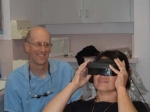 Because virtual reality is a uniquely effective new form of distraction, it makes an ideal candidate for pain control.
Because virtual reality is a uniquely effective new form of distraction, it makes an ideal candidate for pain control.
More to explore
Virtual reality in pain therapy
15:15 Posted in Cybertherapy | Permalink | Comments (0) | Tags: Positive Technology, virtual reality







